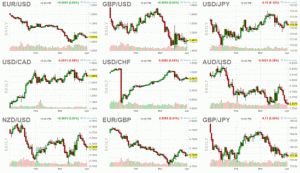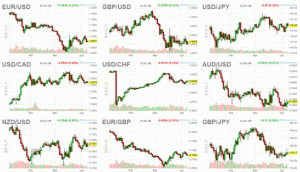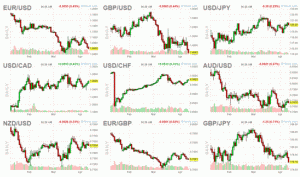PMI Disappoints, ADP Disappoints, Is the S&P 500 Next For Currency Markets?
On Wednesday, the US dollar dropped against most other major currencies in the wake of news that US manufacturing activity in March grew at the lowest rate seen in 14 months, and that nonfarm private employment was weaker than expected. The US dollar Index slipped back 0.24{01de1f41f0433b1b992b12aafb3b1fe281a5c9ee7cd5232385403e933e277ce6} to trade at 98.46, with EUR/USD up 0.46{01de1f41f0433b1b992b12aafb3b1fe281a5c9ee7cd5232385403e933e277ce6} and USD/CAD down 0.37{01de1f41f0433b1b992b12aafb3b1fe281a5c9ee7cd5232385403e933e277ce6}.
PMI data disappoints
The bad news on US manufacturing activity came from the Institute of Supply Management. It reported on Wednesday that its index of purchasing managers was down to 51.5 in March from 52.9 in February. Economists had forecast that the manufacturing PMI would only ease slightly to 52.5. This followed on from news earlier in the day from ADP, the payroll processing firm, that nonfarm private employment fell short of expectations in March, climbing by 189,000. This was well below the expected 225,000.
The next significant data out of the US comes out on Friday with the upcoming jobs report. Investors had anticipated that this would bolster expectations of interest rate increases down the road, but given today’s results, that expectation is now somewhat more muted.
Faster growth in Eurozone
The strong performance in the euro on Wednesday came about as data indicated that manufacturing activity in the Eurozone in March climbed up the quickest pace seen since May, 2014. Traders took this as a signal that the nascent recovery in the region is maintaining its momentum. Data from Markit showed that the Eurozone manufacturing purchasing managers’ index rose to 52.2, up from an initial reading of 51.9.
Across the channel, the British pound held its own against the US dollar, with GBP/USD trading at around 1.4824. Data from Markit showed that the UK manufacturing sector grew strongly in March, mirroring the growth seen in Europe. The manufacturing PMI was up to 54.4 in March, a 0.4 gain from February’s reading of 54.0. Analysts had predicted that the PMI would come in at 54.3.
Japanese business sentiment holds steady
The yen was up on Wednesday, with USD/JPY falling 0.49{01de1f41f0433b1b992b12aafb3b1fe281a5c9ee7cd5232385403e933e277ce6} to trade at 119.53. The rise in the yen came after news that the tankan business sentiment survey from the Bank of Japan remained virtually unchanged in Q1. However, the survey results are expected to get worse this coming quarter.
The Australian dollar was also up, with AUD/USD trading at 0.7631 – a rise of 0.34{01de1f41f0433b1b992b12aafb3b1fe281a5c9ee7cd5232385403e933e277ce6}. On Wednesday, Statistics Australia reported that February building approvals were down 3.2{01de1f41f0433b1b992b12aafb3b1fe281a5c9ee7cd5232385403e933e277ce6}, compared to predictions that they would fall 4.0{01de1f41f0433b1b992b12aafb3b1fe281a5c9ee7cd5232385403e933e277ce6}. Building approvals from January were also revised downwards to a 5.9{01de1f41f0433b1b992b12aafb3b1fe281a5c9ee7cd5232385403e933e277ce6} increase, compared to initial estimates that they had climbed by 7.9{01de1f41f0433b1b992b12aafb3b1fe281a5c9ee7cd5232385403e933e277ce6}. On the other hand, the New Zealand dollar was down 0.25{01de1f41f0433b1b992b12aafb3b1fe281a5c9ee7cd5232385403e933e277ce6}, with NZD/USD changing hands at 0.7451.
The post PMI Disappoints, ADP Disappoints, Is the S&P 500 Next For Currency Markets? appeared first on Forex Signals Provider.
SOURCE: Forex Signals Provider – Read entire story here.



